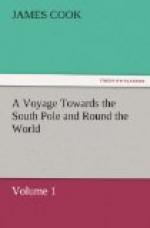In the latitude of 30 deg. 30’ S., longitude 101 deg. 45’ W., we began to see men-of-war birds. In the latitude of 29 deg. 44’, longitude 100 deg. 45’ W., we had a calm for nearly two days together, during which time the heat was intolerable; but what ought to be remarked, there was a great swell from the S.W.
1774 March
On the 6th of March, the calm was succeeded by an easterly wind, with which we steered N.W. till noon the 8th, when being in the latitude of 27 deg. 4’ S., longitude 103 deg. 58’ W., we steered west; meeting every day with great numbers of birds, such as men-of-war, tropic, and egg-birds, podies, sheer-waters, &c. and once we passed several pieces of sponge, and a small dried leaf not unlike a bay one. Soon after, we saw a sea-snake, in every respect like those we had before seen at the tropical islands. We also saw plenty of fish, but we were such bad fishers that we caught only four albacores, which were very acceptable, to me especially, who was just recovering from my late illness.
CHAPTER VII.
Sequel of the Passage from New Zealand to Easter Island, and Transactions there, with an Account of an Expedition to discover the Inland Part of the Country, and a Description of some of the surprising gigantic Statues found in the Island.
1774 March
At eight o’clock in the morning, on the 11th, land was seen, from the mast-head, bearing west, and at noon from the deck, extending from W. 3/4 N. to W. by S., about twelve leagues distant. I made no doubt that this was Davis’s Land, or Easter Island; as its appearance from this situation, corresponded very well with Wafer’s account; and we expected to have seen the low sandy isle that Davis fell in with, which would have been a confirmation; but in this we were disappointed. At seven o’clock in the evening, the island bore from north 62 deg. W., to north 87 deg. W., about five leagues distant; in which situation, we sounded without finding ground with a line of an hundred and forty fathoms. Here we spent the night, having alternately light airs and calms, till ten o’clock the next morning, when a breeze sprung up at W.S.W. With this we stretched in for the land; and by the help of our glass, discovered people, and some of those Colossean statues or idols mentioned in the account of Roggewein’s voyage. At four o’clock p.m. we were half a league S.S.E. and N.N.W. of the N.E. point of the island; and, on sounding, found thirty-five fathoms, a dark sandy bottom. I now tacked, and endeavoured to get into what appeared to be a bay, on the west side of the point or S.E. side of the island; but before this could be accomplished, night came upon us, and we stood on and off, under the land, till the next morning; having sounding from seventy-five to an hundred and ten fathoms, the same bottom as before.




